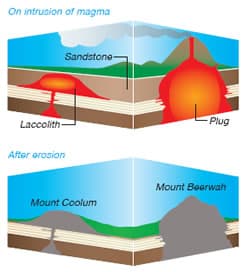Ancient Geology
The Glass House Mountains tell a story
As you gaze at the Glass House Mountains, imagine this view 65 million years ago. Australia was much further south, and still part of the ancient super-continent of Gondwana. The climate was much colder and wetter and much of Australia was covered in tropical rainforest dominated by ferns, conifers and cycads. Slowly but dramatically, Australia separated from Antarctica and began drifting northwards.
Between 30 and 22 million years ago, south-east Queensland was rocked by prolonged volcanic activity, caused by the continent moving over a ‘hot-spot’ in the Earth’s mantle beneath the crust. In the Maleny district about 29 million years ago one or more volcanoes began to erupt basalt lava flows, filling many of the valleys of the district and eventually building up broad, gently sloping plains and shield shaped mountains.

A little later (25 million years ago), numerous dome-like plugs of magma were forced through the surrounding older rocks, filling volcanic vents or subsurface bulges (laccoliths). They are now exposed as the steep sided peaks we know as the spectacular Glass House Mountains. They have resisted erosion while the surrounding softer sandstone rocks have been worn away. Remnants of these flows now cap the Mapleton to Maleny plateau. With erosion of the basalt rocks, fertile soils have built up to enable rainforests like Mary Cairncross Scenic Reserve to re-establish and thrive.
Rainforests reached their most complex stage about 25 million years ago and then began retreating to wetter areas and higher mountain ranges in the face of increasing aridity. Uniquely Australian plant families like Myrtaceae (Eucalypts) and Proteaceae (Banksias) emerged from their rainforest origins and evolved to the drier conditions, though not as dominant as today.

Viewing the Glass House Mountains from Mary Cairncross Scenic Reserve, imagine how different the landscape must have looked in the past. The Glass House Mountains can have been exposed only by the wearing away of great thicknesses of the surrounding Landsborough sandstone. This indicates that the land surface, with its rainforests, was once hundreds of metres higher than at present. The sheer volume of material removed over geological time testifies to the powerful effect of erosion on our landscape.
References
W.F Wilmott & N.C. Stevens, 1988, Rocks and Landscapes of the Sunshine Coast. Geological Society of Australia
Warwick Willmott, 2004, Rocks and Landscapes of the National Parks of Southern Queensland. Geological Society of Australia.
See also . . .
Traditional Owners – European History – History of the Reserve